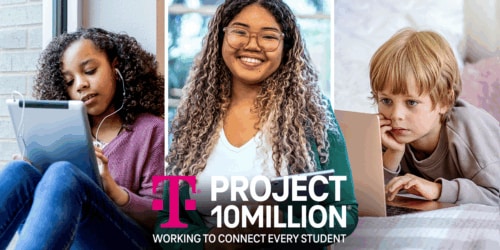Back-to-school season is well underway across the country, and there are signs of pre-pandemic normalcy. But for millions of K-12 students who continue to fall further behind their peers because of an ongoing digital equity gap, life is anything but normal.
Before the pandemic abruptly altered our way of life, Allen Pratt, the executive director for the National Rural Education Association, forecasted in a 2019 op-ed the dangers of inadequate internet access: “Without broadband connectivity, kids living in rural areas are being prepared to compete in a 21st-century economy with 20th-century tools.”
This is exactly why T-Mobile announced our Project 10Million initiative in 2019 and launched it in 2020. We saw this massive issue right in front of us and set out to eradicate it. We activated against an audacious goal of providing 10 million at-risk students with a free hotspot, free or highly subsidized data plans, and access to at-cost laptops and tablets. From inception through the COVID-19 pandemic and to today, we have made offering reliable and affordable connectivity to as many students as possible a priority, investing $3.65 billion in services to connect more than 4.3 million students through collaborations with school districts and student families across the country.
We’ve made great progress — yet there is so much more to do.
Today, in spite of these and other efforts, schools in rural and underserved communities continue to face even bigger problems than any of us — including Allen Pratt — could have predicted. With the struggle for connectivity now combined with learning loss from two years of remote and hybrid classes, this longstanding digital inequity issue has been magnified. Unfortunately, one thing remains consistent: These issues are disproportionately and unfairly hurting kids from low-income households and Black and Hispanic populations. A frightening reality faces a generation of students from minority, rural and low-income populations. The proof is in a Harvard Center for Education Policy report, which found that achievement growth in districts that taught remotely during the pandemic was especially lower for students attending high-poverty schools than it was for students attending low-poverty schools.
And more recently, the National Center for Education Statistics released education progress scores showing just how devastating the last two years of unfinished learning have been for 9-year-old schoolchildren, particularly the most vulnerable. While math and reading scores dipped across the board, Black and Hispanic students lost 13 points and 8 points respectively, compared with five points among white students. Each point lost, according to Andrew Ho, a professor of education at Harvard who was quoted about the scores in a recent New York Times article, is the equivalent of about three weeks of learning. That’s 39 weeks of lost learning for Black students alone.
I’ve shared before that closing the digital equity gap and recovering the learning loss carries serious weight. Research continues to show the long-term implications of disconnected students — affecting academic aptitude, derailing career prospects and ultimately lowering lifetime earnings. For young people to succeed in the classroom, at home and in life, reliable connectivity is not a nice to have. It’s an essential need.
This is why our work continues. We at T-Mobile have taken seriously our responsibility to do our part to help these students access the internet, technology and resources they need to receive an education AND pursue a world of opportunities. Programs like our Project 10Million are no longer a nice-to-have. They are a necessity.
We know that every connection counts, and tackling outreach through innovative approaches will be the key here. While we’ve worked closely with over 1,500 school districts around the U.S. and have options available for consumers to directly participate in the program, we’ve also seen great results from new approaches. We’re partnering with reputable youth networks such as Big Brothers Big Sisters of America, which expands our reach into the nonprofit’s 230 agencies across 5,000 communities. We’re also supporting California’s Emerging Technology Fund that’s working to close the digital divide. T-Mobile’s Project 10Million and the Silicon Valley Education Foundation are joining forces to provide 5,000 student households access to internet connectivity.
Word of mouth is becoming more important, too. This past summer, thanks in part to viral social media posts from moms who are excited about free connectivity through Project 10Million, we saw an uptick in connectivity requests. This not only gets devices and plans in the hands of folks who need them — more than 250,000 directly benefited! — but also helps spotlight the program for those who haven’t heard of it.
I feel increasingly urgent about this topic because time is not on our side. We need to continue talking about it and taking measurable steps to address it. Preparing students for tomorrow largely depends on eliminating the digital equity divide today. Think about it. Many of the roles, skills and titles of the future are actually unknown to us at this moment because they are rooted in innovative technology, according to a PwC report. The World Economic Forum notes in one estimate that 65% of children entering primary school today will end up working in completely new occupations that don’t yet exist. This means the deficit students without digital access face will grow deeper as they build a career in a world that will be mostly automated.
Our nation’s eventual workforce and future leaders — students — are counting on us right now to get them the tools they need to succeed in the future. Programs like T-Mobile’s Project 10Million are here for that reason.
To learn more about Project 10Million, or to register your school district or student for the program, visit t-mobile.com/p10m.





